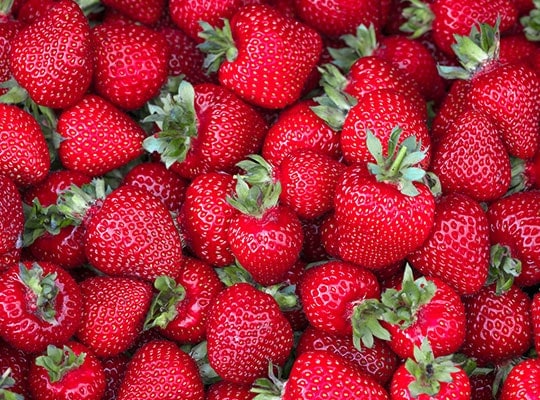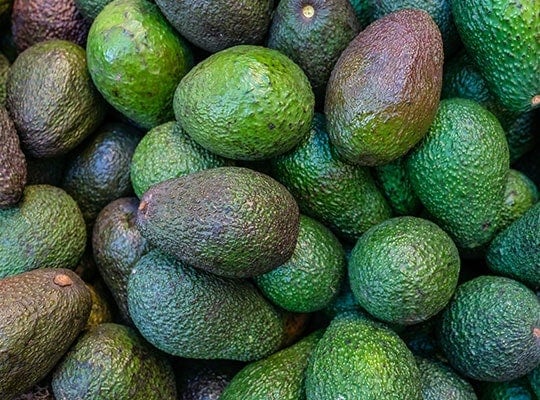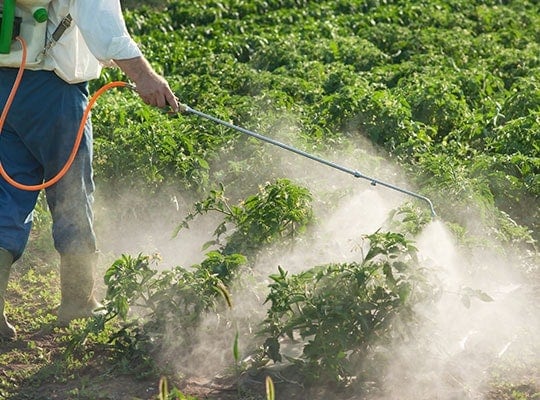by EWG Science Team: 99 Percent of Non-Organic Raisins Tainted With at Least Two Chemicals…
Nearly 70 percent of the fresh produce sold in the U.S. contains residues of potentially harmful chemical pesticides, according to EWG’s analysis of the latest test data from the federal Department of Agriculture. But the dirtiest produce commodity, according to the USDA’s Pesticide Data Program, is not a fresh fruit or vegetable but a dried one – raisins.
Traditionally, EWG’s Shopper’s Guide to Pesticides in Produce™ has included fresh fruits and vegetables only. But because the USDA tested raisins last year for the first time since 2007, we decided to see how they would fare on the Dirty Dozen™, our annual ranking of the fruits and vegetables with the most pesticides.
Almost every sample of non-organic raisins tested – 99 percent – had residues of at least two pesticides. On the 2020 Dirty Dozen, raisins would rank worst of all fruits tested, including strawberries, nectarines, apples and cherries, all of which had residues of two or more pesticides on at least 90 percent of samples.
As with last year’s Shopper’s Guide, kale ranks third on the 2020 Dirty Dozen list. Even as kale’s popularity as a health food rich in vitamins and antioxidants has soared in recent years, the level and type of pesticide residues on kale has expanded significantly.
In USDA’s most recent tests, the pesticide most frequently detected on kale was DCPA, sold under the brand name Dacthal. The Environmental Protection Agency classifies DCPA as a possible human carcinogen, and in 2009 the European Union banned it.
Whether organic or conventionally grown, fruits and vegetables are critical components of a healthy diet. However, many crops contain potentially harmful pesticides, even after washing, peeling or scrubbing, which the USDA does before testing each item. Since pesticide contamination varies by crop, it is important to understand which items are most or least contaminated.
Also important to note is that the USDA does not test for all pesticides used in crop production. Notably, it does not analyze glyphosate, or Roundup, the most heavily used pesticide in the U.S., but high levels can be found in several grains and beans, such as oats and chickpeas, due to its increasing use as a pre-harvest drying agent.

EWG’S DIRTY DOZEN FOR 2020
- Strawberries
- Spinach
- Kale
- Nectarines
- Apples
- Grapes
- Peaches
- Cherries
- Pears
- Tomatoes
- Celery
- Potatoes
Of the 47 items included in our analysis, these Dirty Dozen foods were contaminated with more pesticides than other crops, according to our analysis of USDA data.1 (The rankings are based not only on the percentage of samples with pesticides but also on the number and amount of pesticides on all samples and on individual samples. See Methodology.) Key findings:
- More than 90 percent of samples of strawberries, apples, cherries, spinach, nectarines, and kale tested positive for residues of two or more pesticides.
- Multiple samples of kale showed 18 different pesticides.
- On average, kale and spinach samples had 1.1 to 1.8 times as much pesticide residue by weight than any other crop tested.

EWG’S CLEAN FIFTEEN FOR 2020
- Avocados
- Sweet corn
- Pineapple
- Onions
- Papaya
- Sweet peas (frozen)
- Eggplants
- Asparagus
- Cauliflower
- Cantaloupes
- Broccoli
- Mushrooms
- Cabbage
- Honeydew melon
- Kiwi
These 15 items had the lowest amounts of pesticide residues, according to EWG’s analysis of the most recent USDA data.1 Key findings:
- Avocados and sweet corn were the cleanest. Fewer than 2 percent of samples showed any detectable pesticides
- With the exception of cabbage, all other products on the Clean Fifteen tested positive for four or fewer pesticides.
- Almost 70 percent of Clean Fifteen fruit and vegetable samples had no pesticide residues.
- Multiple pesticide residues are extremely rare on Clean Fifteen vegetables. Only 7 percent of Clean Fifteen fruit and vegetable samples had two or more pesticides.
HEALTH BENEFITS OF REDUCING DIETARY PESTICIDE EXPOSURE
Eating organic food reduces pesticide exposure and is linked to a variety of health benefits, according to an article published this year in the peer-reviewed journal Nutrients.2 In four separate clinical trials, people who switched from conventional to organic foods saw a rapid and dramatic reduction in their urinary pesticide concentrations, a marker of pesticide exposure. Additional studies have linked higher consumption of organic foods to lower urinary pesticide levels, improved fertility and birth outcomes, reduced incidence of non-Hodgkin lymphoma and lower BMI.2,3
Researchers from Harvard University used USDA test data and methods similar to ours to classify produce as having high or low pesticides.4 Remarkably, their lists of high and low pesticide crops largely overlap with our Dirty Dozen and Clean Fifteen.
| FERTILITY STUDIES’ CLASSIFICATION OF PESTICIDE RESIDUES | |
|---|---|
| High pesticide residue score | Apples, apple sauces, blueberries, grapes, green beans, leafy greens, pears, peaches, potatoes, plums, spinach, strawberries, raisins, sweet peppers, tomatoes, winter squashes |
| Low to moderate pesticide residue score | Apple juice, avocados, bananas, beans, broccoli, cabbages, cantaloupes, carrots, cauliflower, celery, corn, eggplants, grapefruits, lentils, lettuce, onions, oranges, orange juices, peas, prunes, summer squashes, sweet potatoes, tofu, tomato sauces, zucchini |
These researchers also found that people who consumed greater quantities of crops high in pesticides had higher levels of urinary pesticides and lower fertility.4,5 Alternatively, people who consumed a pro-fertility diet, which included the low pesticide crops, among other foods and nutrients, like whole grains and folic acid, were more likely to have a successful pregnancy.6
From these studies, it is unclear whether the positive effects associated with organic foods are directly and exclusively caused by lower pesticide exposures.
People who consume higher amounts of organic produce tend to be more health-conscious in general, making it difficult to determine the exact cause of an observed health outcome. Clinical trials – in which participants are monitored before and after switching to an organic diet – may be better able to identify cause-and-effect links between diet and outcomes.
But so far, the clinical trials for organic foods have been short-term studies spanning days to months, although health benefits from eating organic foods may take much longer to become evident. Until long-term clinical trials are completed, the published observational studies provide the best evidence in support of eating organic.
In 2012, the American Academy of Pediatrics issued an important report that said children have “unique susceptibilities to [pesticide residues’] potential toxicity.” The academy cited research that linked pesticide exposures in early life to pediatric cancers, decreased cognitive function and behavioral problems. It advised its members to urge parents to consult “reliable resources that provide information on the relative pesticide content of various fruits and vegetables.” A key resource it cited was EWG’s Shopper’s Guide to Pesticides in Produce.7
An EWG investigation published this year found that for most pesticides, the Environmental Protection Agency does not apply additional restrictions to safeguard children’s health. The landmark 1996 Food Quality Protection Act required the EPA to protect children’s health by applying an extra margin of safety to legal limits for pesticides in food. Yet, as the EWG study found, this tenfold margin of safety was not included in the EPA’s allowable limits for almost 90 percent of the most common pesticides.
GENETICALLY ENGINEERED CROPS
Genetically engineered crops, or GMOs, are most commonly found in processed foods rather than in fresh produce. Corn syrup and corn oil, produced from predominantly GMO starchy field corn, are commonly found in processed foods. However, you may find genetically modified zucchini, yellow squash, sweet corn, papaya and apples in U.S. markets, though only papayas are predominantly GMO.
Under a law passed in 2016, beginning in 2022, GMO food products in the U.S. must be labeled. However, based on the final rule, released in 2018 by the Trump Administration, these labels may be difficult to interpret, with confusing terms like “bioengineered.” Until the law takes effect, consumers who want to avoid GMOs may choose organic zucchini, yellow squash, sweet corn, papaya, apples and potatoes. Processed goods that are certified organic or bear Non-GMO Project Verified labels can also be trusted to be GMO-free.
EWG provides several resources – including EWG’s Shopper’s Guide To Avoiding GMO Food, the Food Scores database and EWG’s Healthy Living app – to help consumers identify foods likely to contain genetically engineered ingredients.
DIRTY DOZEN PLUS™
EWG’s standard criteria do not rank peppers among the Dirty Dozen, but because they test positive for pesticides known to be toxic to the brain, we’ve included them in the Dirty Dozen Plus™ list.
Between 2010 and 2012, USDA tests found peppers contained acephate, chlorpyrifos and oxamyl – toxic insecticides that are banned from use on some crops but still permitted on hot peppers.
EWG recommends that consumers choose organic peppers in lieu of conventionally grown. Alternatively, if organic peppers are unavailable or too expensive, EWG suggests that you cook conventionally grown peppers before eating them, as heating food can reduce pesticide levels.8

PESTICIDE REGULATIONS
The federal government’s role in protecting our health, farm workers and the environment from harmful pesticides is in urgent need of reform. In the U.S, pesticide regulation, monitoring and enforcement is scattered across multiple federal and state agencies. In 1991 the USDA initiated the Pesticide Data Program and began testing commodities annually for pesticide residues, but we continue to be concerned about pesticide regulation in the U.S.
The USDA states that a goal of its tests is to provide data on pesticide residues in food, with a focus on those most likely consumed by infants and children. Yet there are some commodities that are not tested annually, including baby food (last tested in 2013), oats (last tested in 2014), and baby formula (last tested in 2014).
This is troubling, because tests commissioned by EWG found almost three-fourths of samples of popular oat-based foods, including many consumed by children, had pesticide residue levels higher than what EWG scientists consider protective of children’s health.
The chief responsibility of deciding which pesticides are approved for use in the U.S., including deciding what conditions are placed on their approval and setting the pesticide residue levels on foods and crops, falls to the EPA. But primary enforcement authority for pesticide use on farms is left to states, and the responsibility of testing foods to determine dietary exposures to pesticides is divided between the USDA and the Food and Drug Administration. However, neither the USDA nor the FDA regularly test all commodities for pesticide residues, nor do the programs test for all pesticides commonly used in agriculture.
The pesticide registration process requires companies to submit safety data, proposed uses and product labels to be approved by the EPA. However, the EPA does not conduct its own independent testing of pesticides. Neither does its review fully capture the risks posed by pesticides, because of limitations in available data and failures in risk assessments, such as excluding synergistic effects. This is concerning, because scientists have found that the combination of two or more pesticides can be more potent than the use of the pesticides individually.
The primary pesticide law – the Federal Insecticide, Fungicide, and Rodenticide Act, or FIFRA – is far less health protective than the laws that protect the safety of our air, food, water and environment. There are many reasons EWG fights for pesticide regulation and reform: registration loopholes, limited public participation, outdated registration and pesticide registration backlogs, to name a few.
These are examples of the potential undermining of marketplace safety, since products with harmful health concerns can remain on the market. Not all pesticides registered under FIFRA adequately protect human health and the environment, and federal food tolerance residue levels often allow for higher exposure levels than public health advocates, including EWG, consider to be safe.
METHODOLOGY
The Shopper’s Guide ranks pesticide contamination on 47 popular fruits and vegetables based on an analysis of more than 43,700 samples taken by the USDA and the FDA. Each year the USDA selects a subset of these fruits and vegetables to test, rather than testing each crop each year.
To create this guide, EWG uses data from the most recent one-to-two-year sampling period for each food. Since the USDA doesn’t test honeydew melons, EWG uses the FDA’s pesticide monitoring data for this crop.
| FOOD | YEAR | SOURCE |
|---|---|---|
| Apples | 2014-2016 | USDA PDP |
| Asparagus | 2017-2019 | USDA PDP |
| Avocados | 2012 | USDA PDP |
| Bananas | 2012-2014 | USDA PDP |
| Blueberries | 2014 | USDA PDP |
| Broccoli | 2013-2014 | USDA PDP |
| Cabbages | 2017-2019 | USDA PDP |
| Cantaloupe | 2010-2012 | USDA PDP |
| Carrots | 2013-2014 | USDA PDP |
| Cauliflower | 2012-2013 | USDA PDP |
| Celery | 2013-2014 | USDA PDP |
| Cherries | 2014-2016 | USDA PDP |
| Cherry tomatoes | 2012 | USDA PDP |
| Cucumbers | 2015-2017 | USDA PDP |
| Eggplant | 2005-2006 | USDA PDP |
| Grapefruit | 2015-2017 | USDA PDP |
| Grapes | 2015-2016 | USDA PDP |
| Green beans | 2013-2016 | USDA PDP |
| Honeydew | 2008-2015 | FDA |
| Hot peppers | 2010-2011 | USDA PDP |
| Kale | 2017-2018 | USDA PDP |
| Kiwis | 2018 | FDA |
| Lettuce | 2015-2017 | USDA PDP |
| Mangoes | 2017-2018 | USDA PDP |
| Mushrooms | 2011-2013 | USDA PDP |
| Nectarines | 2013-2015 | USDA PDP |
| Onions | 2017 | USDA PDP |
| Oranges | 2015-2016 | USDA PDP |
| Papaya | 2011-2012 | USDA PDP |
| Peaches | 2013-2015 | USDA PDP |
| Pears | 2015-2016 | USDA PDP |
| Pineapple | 2000-2002 | USDA PDP |
| Plums | 2011-2013 | USDA PDP |
| Potatoes | 2015-2016 | USDA PDP |
| Raspberries | 2013 | USDA PDP |
| Snap peas | 2017-2018 | USDA PDP |
| Spinach | 2015-2016 | USDA PDP |
| Strawberries | 2014-2016 | USDA PDP |
| Summer squash | 2012-2014 | USDA PDP |
| Sweet bell peppers | 2011-2012 | USDA PDP |
| Sweet corn | 2014-2015 | USDA PDP |
| Sweet peas (canned/frozen) | 2018-2019 | USDA PDP |
| Sweet potatoes | 2016-2018 | USDA PDP |
| Tangerines | 2012 | USDA PDP |
| Tomatoes | 2014-2016 | USDA PDP |
| Watermelon | 2014-2015 | USDA PDP |
| Winter squash | 2011-2013 | USDA PDP |
Before testing, the USDA processes each fruit or vegetable in the same way that people tend to do at home. For example, items with inedible peels are peeled, and those with edible peels are rinsed under cold water and drained before testing. Therefore, the USDA test results are a good indication of consumers’ likely exposure. Unprocessed produce tends to have higher concentrations of pesticides, as shown by testing by the California Department of Pesticide Regulation.
To compare foods, EWG looked at six measures of pesticide contamination:
- Percent of samples tested with detectable pesticides.
- Percent of samples with two or more detectable pesticides.
- Average number of pesticides found on a single sample.
- Average amount of pesticides found, measured in parts per million.
- Maximum number of pesticides found on a single sample.
- Total number of pesticides found on the crop.
Within each of these categories, we ranked the 47 fruits and vegetables and then normalized the ranks on a scale of 1 to 100, with 100 being the highest. For each food, we calculated a total score by summing the normalized rank from each metric. All categories are weighted equally, since they convey different but equally relevant information about pesticide levels on produce. The USDA test program includes both domestically grown and imported produce, and sometimes ranks differ on the basis of origin. In these cases, we displayed domestic and imported items separately to help you select the option with the lowest pesticide levels.
The Shopper’s Guide full list shows how fruits and vegetables rank based on these total scores.
The Shopper’s Guide does not incorporate risk assessment into the calculations. All pesticides are weighted equally, and we do not factor in the levels deemed acceptable by the EPA. Research is constantly providing new insights into the threats posed to human and environmental health by pesticides. EWG designed this method to capture this uncertainty and enable consumers to reduce their overall pesticide load.















































